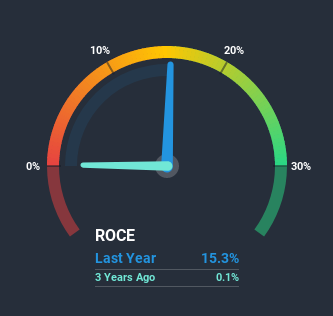The Returns On Capital At Korvest (ASX:KOV) Don't Inspire Confidence
When it comes to investing, there are some useful financial metrics that can warn us when a business is potentially in trouble. Businesses in decline often have two underlying trends, firstly, a declining return on capital employed (ROCE) and a declining base of capital employed. This combination can tell you that not only is the company investing less, it's earning less on what it does invest. So after we looked into Korvest (ASX:KOV), the trends above didn't look too great.
What is Return On Capital Employed (ROCE)?
For those who don't know, ROCE is a measure of a company's yearly pre-tax profit (its return), relative to the capital employed in the business. Analysts use this formula to calculate it for Korvest:
Return on Capital Employed = Earnings Before Interest and Tax (EBIT) ÷ (Total Assets - Current Liabilities)
0.15 = AU$5.6m ÷ (AU$46m - AU$9.4m) (Based on the trailing twelve months to December 2019).
So, Korvest has an ROCE of 15%. In absolute terms, that's a satisfactory return, but compared to the Machinery industry average of 6.8% it's much better.
See our latest analysis for Korvest

In the above chart we have a measured Korvest's prior ROCE against its prior performance, but the future is arguably more important. If you'd like, you can check out the forecasts from the analysts covering Korvest here for free.
So How Is Korvest's ROCE Trending?
We are a bit worried about the trend of returns on capital at Korvest. To be more specific, the ROCE was 21% five years ago, but since then it has dropped noticeably. Meanwhile, capital employed in the business has stayed roughly the flat over the period. Companies that exhibit these attributes tend to not be shrinking, but they can be mature and facing pressure on their margins from competition. So because these trends aren't typically conducive to creating a multi-bagger, we wouldn't hold our breath on Korvest becoming one if things continue as they have.
The Key Takeaway
In summary, it's unfortunate that Korvest is generating lower returns from the same amount of capital. Yet despite these concerning fundamentals, the stock has performed strongly with a 46% return over the last five years, so investors appear very optimistic. Regardless, we don't feel to comfortable with the fundamentals so we'd be steering clear of this stock for now.
On a separate note, we've found 2 warning signs for Korvest you'll probably want to know about.
If you want to search for solid companies with great earnings, check out this free list of companies with good balance sheets and impressive returns on equity.
When trading Korvest or any other investment, use the platform considered by many to be the Professional's Gateway to the Worlds Market, Interactive Brokers. You get the lowest-cost* trading on stocks, options, futures, forex, bonds and funds worldwide from a single integrated account. Promoted
Valuation is complex, but we're here to simplify it.
Discover if Korvest might be undervalued or overvalued with our detailed analysis, featuring fair value estimates, potential risks, dividends, insider trades, and its financial condition.
Access Free AnalysisThis article by Simply Wall St is general in nature. It does not constitute a recommendation to buy or sell any stock, and does not take account of your objectives, or your financial situation. We aim to bring you long-term focused analysis driven by fundamental data. Note that our analysis may not factor in the latest price-sensitive company announcements or qualitative material. Simply Wall St has no position in any stocks mentioned.
*Interactive Brokers Rated Lowest Cost Broker by StockBrokers.com Annual Online Review 2020
Have feedback on this article? Concerned about the content? Get in touch with us directly. Alternatively, email editorial-team@simplywallst.com.
About ASX:KOV
Korvest
Manufactures and supplies cable and pipe support systems, fastening solutions, and galvanising services in Australia.
Outstanding track record with flawless balance sheet and pays a dividend.
Market Insights
Community Narratives




